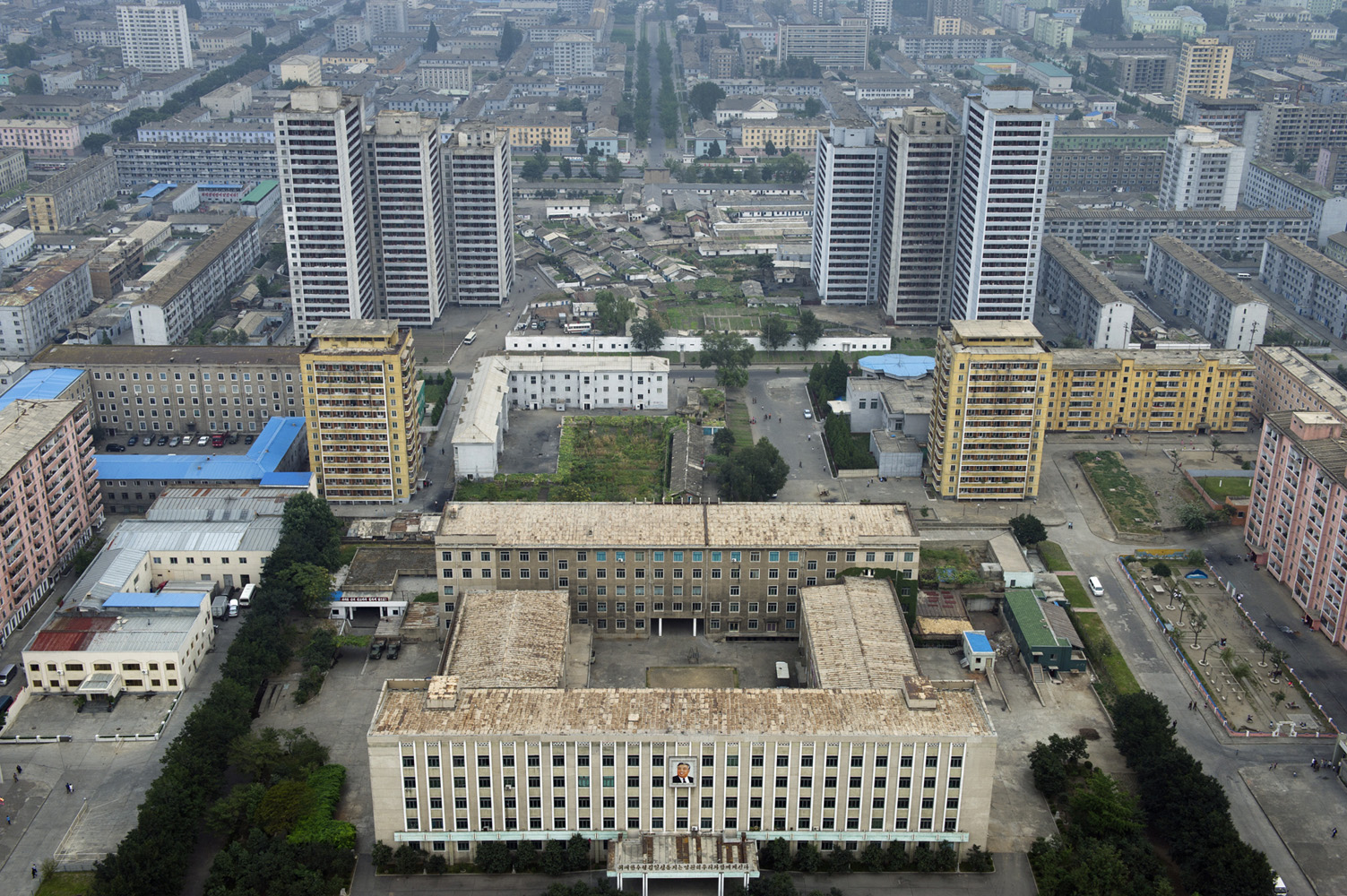
North Korean students on their way up to the holy mountain Baekdu (2744 m above sea level), the highest mountain in North Korea. Kim Jong-il's official biography states that he was born in a secret military camp on Baekdu Mountain. Dense forest around the mountain provided bases for Korean armed resistance against the Japanese occupation, and later communist guerrillas during the Korean War. The Baekdu Mountain has been worshipped by the surrounding peoples throughout history. Both the Koreans and Manchus consider it the place of their ancestral origin.

Man bicycling under a world map mural at Songdowon International Children's Union Camp in Wŏnsan, Kangwŏn Province.

Man on a bicycle outside Hamhŭng Grand Theatre. Hamhŭng is an important chemical industry center in the DPRK. It is an industrial city which serves as a major port for North Korean foreign trade. Production includes textiles (particularly vinalon), metalware, machinery, refined oil and processed food. It is also said to be North Korea's largest center of methamphetamine production both for export and illicitly for internal consumption.

Pyongyang Metro, built 1981, has 17 station and a daily ridership is estimated to be between 300,000 and 700,000. Pyongyang Metro is one of the deepest metro in the world—the track is approximately 110 meters underground.

North Korean student holding a red flag on top of the volcanic mountain Baekdu (2744 m above sea level), the highest mountain in North Korea, with Chon Crater Lake in the background. Kim Jong-il's official biography states that he was born in a secret military camp on Baekdu Mountain. Dense forest around the mountain provided bases for Korean armed resistance against the Japanese occupation, and later communist guerrillas during the Korean War. The Baekdu Mountain has been worshipped by the surrounding peoples throughout history. Both the Koreans and Manchus consider it the place of their ancestral origin.

Reflection of a soldier outside Hamhŭng Grand Theatre. Hamhŭng is an important chemical industry center in the DPRK. It is an industrial city which serves as a major port for North Korean foreign trade. Production includes textiles (particularly vinalon), metalware, machinery, refined oil and processed food. It is also said to be North Korea's largest center of methamphetamine production both for export and illicitly for internal consumption.

Young Koreans dancing in front of a Monument, Workers' Party of Korea (sickle, hammer and brush), on the national day.

Man standing in front of a building with a painting of Kim Il-Sung in Hamhŭng city. Hamhŭng is an important chemical industry center in the DPRK. It is an industrial city which serves as a major port for North Korean foreign trade. Production includes textiles (particularly vinalon), metalware, machinery, refined oil and processed food.

Reflection of people walking outside Hamhung Grand Theatre. Hamhŭng is an important chemical industry center in the DPRK. It is an industrial city which serves as a major port for North Korean foreign trade. Production includes textiles (particularly vinalon), metalware, machinery, refined oil and processed food. It is also said to be North Korea's largest center of methamphetamine production both for export and illicitly for internal consumption.

Pyongyang Metro, built 1981, has 17 station and a daily ridership is estimated to be between 300,000 and 700,000. Pyongyang Metro is one of the deepest metro in the world—the track is approximately 110 meters underground.

North Korean woman standing at the stairs of the tower of the Juche Idea, a 170-meter tall monument. It is presumed to be modeled on the Washington Monument, which it surpasses in height by less than a metre.

Kim Il-sung Square is a city square in Pyongyang, Democratic People's Republic of Korea, and is named after the founding leader of the DPRK, Kim Il-sung. Opened in August 1954, the square is located on the west bank of the Taedong River, directly opposite the Juche Tower on the other side of the river. The square is a common gathering place for rallies, dances and military parades and is often featured in media concerning North Korea. It is the 16th largest square in the world, having an area of about 75,000 square meters (807,293 square feet) which can accommodate a rally of more than 100,000 people.

Live music on the national day in North Korea, with a band playing in front of a Communist propaganda bulletin board.

Tourists from Pyongyang visiting the Kuriong Waterfall. Since 1998, South Korean tourists have been allowed to visit the Kŭmgangsan area, a special administrative region of North Korea, that was developed by the South Korean company Hyundai Asan. The Kŭmgangsan Tourist Region is thought to be one way for the North Korean government to receive hard currency from abroad. In the summer of 2008 a South Korean tourist was shot to death by North Korean soldiers, and all South Korean tourism stopped.

View of Pyongyang city from the Tower of the Juche Idea, a 170-meter tall monument. It is presumed to be modeled on the Washington Monument, which it surpasses in height by less than a metre.







